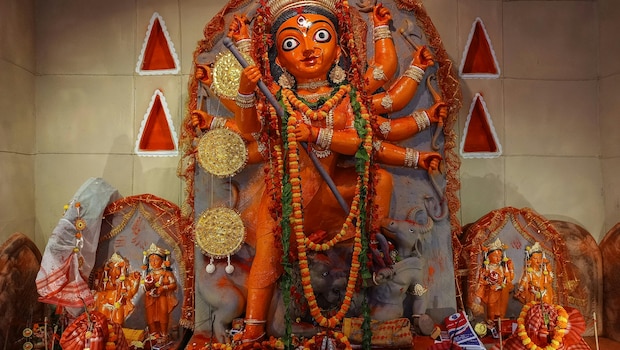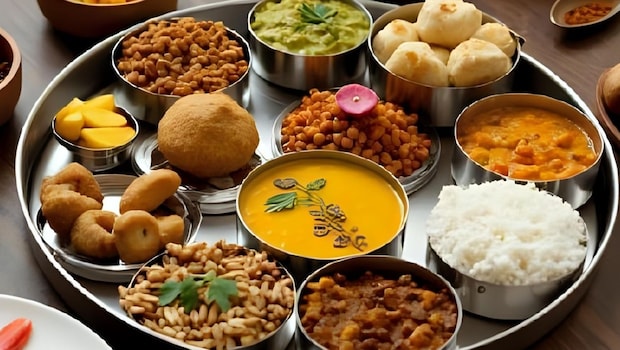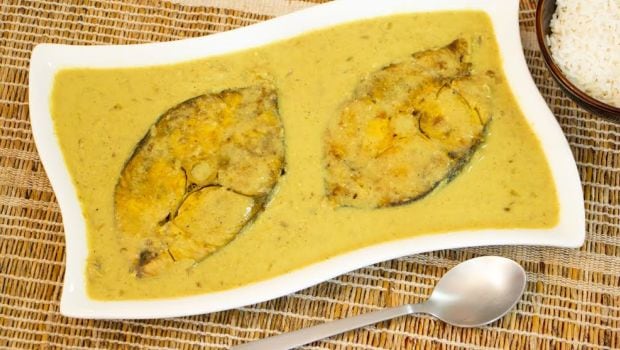Navratri is just around the corner, and much of India is preparing to observe nine days of fasting and devotion to the nine avatars of Ma Durga. During this time, thalis across the country are dominated by sabudana khichdi, fruit platters, kuttu puris and other sattvik meals. Meat, onion and garlic quietly disappear from plates. But travel east to Bengal, and the narrative takes a sharp turn. Here, it marks the beginning of the state's grandest celebration - Durga Puja. The air fills with the aroma of kosha mangsho, ilish machh and chicken curry simmering in Bengali kitchens. For many outside Bengal, this contrast can be surprising. How can a festival, rooted in devotion, be celebrated with non-vegetarian food?
For Bengalis, eating fish and meat during Navratri is not an act of rebellion. It is a tradition, culture and a celebration of Ma Durga's homecoming. It is devotion expressed through feasting, not fasting.
Also Read: Sharad Navratri 2025: Explore New Thalis And Menus At Top Restaurants Across India
Navratri In Bengal: More About Celebration Than Fasting
In Bengal, Navratri is not just about fasting and restraint. It is the lead-up to Durga Puja, the region's most important cultural and religious festival. Unlike the North Indian interpretation, which emphasises abstinence, in Bengal Navratri is viewed as a time of joy, indulgence and community bonding.
This emotional peg changes the way Bengalis celebrate. Instead of abstinence, there is festivity, community bonding and spending time and creating memories with family and friends. Non-vegetarian food, particularly fish and meat, becomes part of that festive spread.

Photo Credit: file photo
The Historical And Cultural Context:
Food habits in Bengal have been shaped by geography and history. Surrounded by rivers and fertile land, fish has been central to Bengali cuisine for centuries. Historian Nrisingha Bhaduri explains that in Bengal, consuming fish and meat during religious festivals has long been considered a form of divine blessing. The idea that food can be both sacred and celebratory sits comfortably in Bengali tradition.
In fact, many temple rituals in Bengal actively involve non-vegetarian offerings. The worship of Kali, another fierce form of the goddess, often includes goat sacrifices, with the meat later cooked and shared as prasad. Durga herself is worshipped with bhog that features khichuri, fried vegetables, and in some communities even fish and meat.
This is in contrast with parts of India influenced by Vaishnavite traditions, where vegetarianism is seen as the purest form of devotion. Bengal's Shakta traditions, centred around goddess worship, consider both vegetarian and non-vegetarian offerings as equally sacred.
Also Read: Pujo Special: How To Make The Delectable Bengali Kosha Mangsho For Durga Puja (Watch Video)
A Practical Perspective: Bengal's Climate And Food Habits
Beyond religion, there is a practical reason too. Bengal's humid climate and river-rich geography made fish the staple protein of the region. Generations grew up considering fish not just food but an essential daily nutrient. To suddenly give it up for nine days of Navratri never became a cultural norm in Bengal the way it did in other states.
Unlike arid regions where vegetarian diets were more sustainable, Bengal's bounty of rivers made non-vegetarian food both accessible and affordable.

Navratri special thali
Photo Credit: Canva
What Bengalis Actually Eat During Navratri:
So, what does a typical Bengali plate look like during Navratri? The most popular dishes are:
- Kosha Mangsho - slow-cooked mutton curry, dark, rich and paired with luchis (deep-fried puffed bread).
- Ilish Machh - the beloved hilsa, often steamed in mustard or fried golden.
- Chicken Curry With Potatoes - a homely favourite, often part of weekend family meals.
- Mutton Biryani - especially in Kolkata, where biryani with a piece of potato is sacred.
- Fish Fry And Fish Curry - from rui to bhetki, fish remains central to Navratri meals.
- Bhog at Pandals - vegetarian khichuri, labra, chutney and payesh (rice kheer) served to devotees.
Also Read: 5 Of The Most Favourite Bengali Fishes And Recipes You Must Try

Photo Credit: file photo
The contrast is striking. At pandals, you get a wholesome vegetarian bhog, but at home, kitchens fill with the aroma of mutton and fish. For Bengalis, the two coexist happily. And how can we forget the street foods. There's phuchka, egg roll, chicken roll, chowmein, Mughlai paratha, chop, cutlet and the list goes on.
Also Read: Durga Puja: Prepare This Special Bengali Tomato Chutney At Home For Bhog
Navratri In North Vs Navratri In East:
In states like Uttar Pradesh, Gujarat and Rajasthan, Navratri fasting is marked by complete abstinence from grains, pulses, onion, garlic and certainly meat. Restaurants across these regions even switch to "Navratri menus" featuring vrat thalis, kuttu puris and paneer-based dishes.
Meanwhile, in Bengal, you will find stalls selling biryani, fish fry, egg rolls and mutton curry near Durga Puja pandals. For Bengalis, this is not disrespectful, it is festive indulgence.
The contrast shows how regional cultures shape religious practices. The same festival can look entirely different depending on where you are in India.
Also Read: Bhog-er Mangsho Recipe: This Bengali-Style Meat Dish Is Served To The Gods

Photo Credit: iStock
Navratri Food Practices Across India:
Navratri is one festival, but the food traditions look very different depending on where you are in India:
- North India (Uttar Pradesh, Delhi, Haryana, Punjab): Fasting foods like kuttu puris, sabudana khichdi, paneer and aloo preparations dominate. Onion and garlic are avoided.
- Gujarat And Maharashtra: Navratri is about garba nights and vrat thalis, with snacks like farali dhokla and rajgira laddoo.
- South India (Tamil Nadu, Karnataka, Andhra Pradesh): Homes display dolls in the Golu festival, and families host guests with sundal (spiced lentils) and sweet dishes.
- West Bengal: Non-vegetarian food flows freely, with fish, chicken and mutton forming part of family feasts, while vegetarian bhog remains central at pandals.
The diversity highlights India's cultural variety. And it is precisely this variety that makes Navratri such a rich celebration across the country. Whether it is sabudana khichdi in Uttar Pradesh, sundal in Tamil Nadu, or kosha mangsho in West Bengal, Navratri is proof that food is central to how Indians celebrate faith.
Happy Navratri 2025, everyone!
About Somdatta SahaExplorer- this is what Somdatta likes to call herself. Be it in terms of food, people or places, all she craves for is to know the unknown. A simple aglio olio pasta or daal-chawal and a good movie can make her day.




